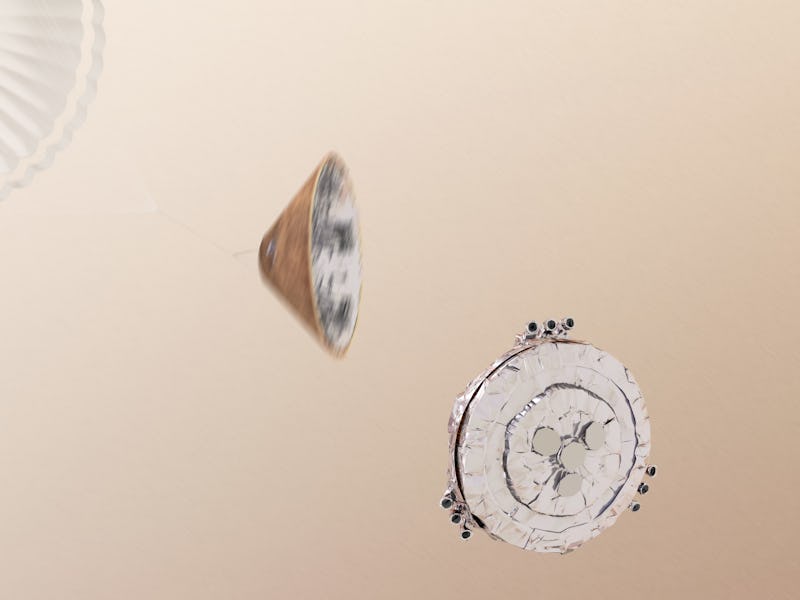The European Space Agency lost contact with its Schiaparelli Mars lander on Wednesday as the spacecraft descended to the surface of the Red Planet. The ESA now says its billon-dollar lander hit the planet too hard, and may have blown up, according to an analysis of new images of the possible crash site taken by NASA.
Those images, acquired Thursday by the Mars Reconnaissance Orbiter (MRO), illustrate two big changes on the Martian landscape: a dark splotch, and a white speck. Scientists with the ESA believe these might be Schiaparelli’s parachute and the aftermath of its crash to the surface.
According to a news update on ESA’s website:
“Estimates are that Schiaparelli dropped from a height of between two and four kilometers, therefore impacting at a considerable speed, greater than 300 km/h [186 mph]. The relatively large size of the feature would then arise from disturbed surface material. It is also possible that the lander exploded on impact, as its thruster propellant tanks were likely still full.”
A pair of before-and-after images taken by the Context Camera (CTX) on NASA's Mars Reconnaissance Orbiter, on 29 May 2016 and 20 October 2016, show two new features appearing, following the arrival of the Schiaparelli test lander module on 19 October 2016.
Schiaparelli was jettisoned from the ExoMars mission’s Trace Gas Orbiter (TGO) on Sunday, and set course for the Red Planet, while avoiding an outright free fall into the planet’s atmosphere. On Wednesday, the spacecraft executed a descent to the surface that was meant to last six minutes — during which it collected a broad swath of data on Martian atmosphere and relayed it back to TGO (a sort of ‘mothership’ for the ExoMars mission).
Unfortunately, the ESA lost contact with the lander shortly before Schiaparelli was set to touchdown in the Meridiani Planum region of the planet.
ESA officials believe Schiaparelli deployed its parachute as planned, but that there was a problem in the final portion of the landing sequence. The spacecraft’s nine thrusters seem to have turned off too early, and Schiaparelli ended up dropping onto the ground in a fatal, explosive thump.
MRO was able to snap images of the purported landing site on Thursday. NASA and ESA officials compared those pictures to ones of the same site taken in May. A statement issued by NASA said, in part:
”The area indicated with a black outline is enlarged at right. The bright spot near the lower edge of the enlargement is interpreted as likely to be the lander’s parachute, which was deployed and then released during the descent through the Martian atmosphere[.]The larger dark spot near the upper edge of the enlargement was likely formed by the Schiaparelli lander. The spot is elliptical, about 50 by 130 feet (15 by 40 meters) in size, and is probably too large to have been made by the impact of the heat shield.”
The landing site of the Schiaparelli module within the predicted landing ellipse in a mosaic of images from the Context Camera (CTX) on NASA's Mars Reconnaissance Orbiter, and the Thermal Emission Imaging System (THEMIS) on NASA's 2001 Mars Odyssey orbiter.
A more powerful camera on MRO will take pictures next week, and they should reveal the location of Schiaparelli’s heat shield (which was dropped at a higher altitude during the descent).
ESA is still investigating exactly what might have caused the thruster anomaly.
Meanwhile, TGO is working perfectly fine, and ESA, along with ExoMars mission partner Roscosmos (Russia’s space agency) will be moving forward with the orbiter’s scientific investigations as planned. It’s still unclear if, and how, Schiaparelli’s loss might affect the second phase of the ExoMars mission: the delivery of a rover to the Martian surface in 2020.
